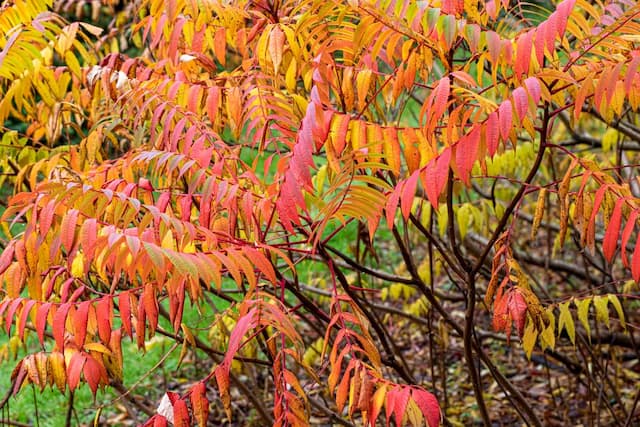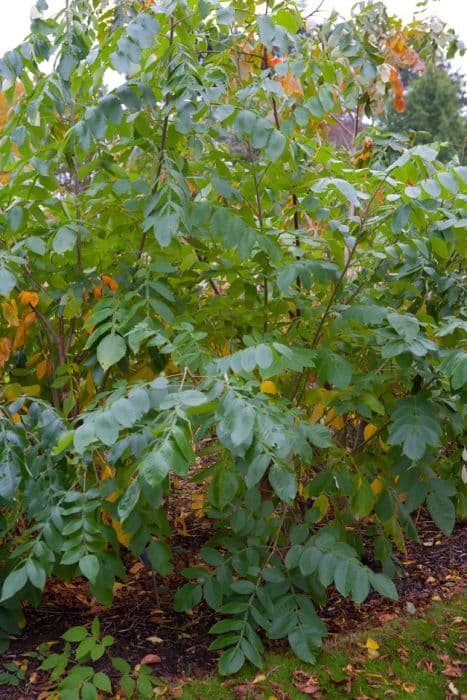Staghorn Sumac Rhus typhina

ABOUT
The plant commonly known as staghorn sumac is notably recognizable for its distinct appearance. It showcases compound leaves that can be quite large, comprised of many long, slender leaflets which are serrated along the edges. These leaflets are attached to a central stem, making the whole leaf structure somewhat resemble a feather. During the growing season, the leaves are a vibrant green, turning to dramatic shades of red, orange, and yellow as autumn arrives. The staghorn sumac is named for its velvety branches and twigs, which bear a striking resemblance to the antlers of a stag as they are shed and regrow. This velvety texture provides a unique tactile quality not found in many other plants. Flowering occurs in this plant producing dense clusters of tiny, greenish-yellow flowers. As the season progresses, these flowers give way to fruit clusters that are perhaps one of the most distinctive features of the staghorn sumac. The fruit appears as dense, upright clusters of small red berries, which persist through winter and provide visual interest as well as a food source for wildlife. The bark of the staghorn sumac adds to its overall texture with a rough surface that peels and flakes over time. It contributes to the rugged, somewhat wild look of the plant, which is often used in landscaping to create a naturalistic or rustic aesthetic. Overall, the staghorn sumac is a striking plant with features that are both visually attractive and distinct in feeling, with colors that evolve through the seasons.
About this plant
 Names
NamesSynonyms
Staghorn Sumac, Velvet Sumac, Hairy Sumac, Virginian Sumac, Typhina.
Common names
Rhus hirta, Rhus typhina var. hirta, Rhus viridiflora, Schmaltzia hirta, Schmaltzia typhina.
 Toxicity
ToxicityTo humans
Staghorn sumac, though often used for its red berries in spice mixes and teas after proper processing, can be toxic if consumed in its raw form or if other parts of the plant are ingested. This is due to the presence of urushiol, a compound also found in poison ivy which can cause a severe allergic skin reaction in susceptible individuals. Ingestion of significant quantities can also result in gastrointestinal irritation, nausea, vomiting, and diarrhea. Urushiol can cause a rash upon contact with the skin, and if ingested, the internal mucous membranes can become inflamed.
To pets
Staghorn sumac could potentially be toxic to pets when ingested, particularly if they consume the leaves or stems that contain urushiol, an irritant substance that can also cause contact dermatitis in humans. The symptoms in pets might include vomiting, diarrhea, and abdominal pain due to gastrointestinal irritation if they ingest parts of the plant. Additionally, if pets come into contact with the plant and then lick their fur, they may experience oral irritation and inflammation, difficulty swallowing, and drooling. In cases of skin contact, pets could develop a rash similar to the one caused by poison ivy.
 Characteristics
CharacteristicsLife cycle
Perennials
Foliage type
Deciduous
Color of leaves
Green
Flower color
Greenish-yellow
Height
15-25 feet (4.5-7.6 meters)
Spread
10-30 feet (3-9 meters)
Plant type
Shrub
Hardiness zones
3-8
Native area
North America
Benefits
 General Benefits
General Benefits- Landscape Aesthetics: Rhus typhina, commonly known as the staghorn sumac, is visually striking with its velvety branches and fiery red foliage in the fall, adding aesthetic value to gardens and landscapes.
- Wildlife Habitat: The plant provides shelter and nesting sites for birds and other wildlife, creating a mini ecosystem in your garden.
- Soil Erosion Control: Staghorn sumac has an extensive root system that can help stabilize soil and prevent erosion on slopes.
- Food Source for Wildlife: Its berries serve as a food source for various bird species, particularly in winter when food is scarce.
- Drought Resistance: Once established, staghorn sumac is highly drought-tolerant, making it an excellent choice for xeriscaping and low-water landscapes.
- Easy Propagation: It propagates easily from cuttings and root suckers, making it simple to spread or share with others.
- Natural Dye: The plant's berries have historically been used for making a natural dye, used in textile coloring.
 Medical Properties
Medical Properties- Antimicrobial: Rhus typhina possesses compounds that can inhibit the growth of bacteria and other microorganisms.
- Astringent: The tannins present in the plant may have astringent properties, which can help in toning tissues and reducing bleeding.
- Anti-inflammatory: Some traditional use suggests that the plant has anti-inflammatory effects, which could help in reducing swelling and inflammation.
- Gastrointestinal relief: It has been used to ease gastrointestinal issues such as diarrhea due to its astringent properties.
- Diuretic: The plant has been used traditionally as a diuretic to help flush out excess fluids from the body.
 Air-purifying Qualities
Air-purifying QualitiesThis plant is not specifically known for air purifying qualities.
 Other Uses
Other Uses- Rhus typhina branches can be used in the construction of rustic furniture due to their distinctive forms and strength.
- The sumac's vibrant fall foliage can be used as a natural dye to color fabrics and yarns with warm tones.
- In landscape design, Rhus typhina can be planted to stabilize slopes and prevent erosion, thanks to its robust root system.
- The plant's dried seed heads are often used in floral arrangements, adding a unique texture and visual interest.
- Rhus typhina wood can be used in small-scale carving projects as it is relatively soft and easy to work with.
- The tannin-rich bark has historical use in the tanning industry for processing leather.
- Fallen Rhus typhina leaves can be gathered and used as a mulch to enrich garden soil as they decompose.
- The distinctive shape and texture of the plant make it a popular choice for photography and botanical illustration subjects.
- Rhus typhina can be used in permaculture designs as part of a guild planting that supports beneficial insects and increases biodiversity.
- The sap from Rhus typhina can be harvested and experimented with as a natural adhesive or glue-like substance for crafts.
Interesting Facts
 Feng Shui
Feng ShuiThe Staghorn Sumac is not used in Feng Shui practice.
 Zodiac Sign Compitability
Zodiac Sign CompitabilityThe Staghorn Sumac is not used in astrology practice.
 Plant Symbolism
Plant Symbolism- Resilience: Staghorn sumac is known for its ability to grow in a variety of conditions, symbolizing adaptability and resilience in the face of challenges.
- Healing: Traditionally, parts of the staghorn sumac have been used for medicinal purposes, representing healing and the power of nature in restoring health.
- Protection: The plant's vigorous nature and ability to spread quickly signify protection and the idea of creating a safe space or territory.
- Transformation: With its bright red fall foliage, staghorn sumac symbolizes transformation and change, reminding us of the cyclical nature of life and the beauty within transitions.
 Water
WaterThe Staghorn Sumac (Rhus typhina) prefers to be watered when the top inch of soil feels dry, which typically means watering approximately once a week depending on the climate and season. It is better to water it deeply and less frequently to encourage strong root growth; an estimated amount of 2 gallons per week for an established outdoor plant should suffice. During the growing season in spring and summer, be attentive to the soil moisture, and reduce watering in the fall and winter when the plant is dormant. Overwatering can lead to root rot, so ensure good drainage and avoid letting the plant sit in waterlogged soil.
 Light
LightStaghorn Sumac thrives best in full sun to partial shade conditions. It benefits from at least 6 hours of direct sunlight daily, making it ideally suited for a spot that receives plenty of morning and afternoon light. However, it can also tolerate light shade, especially in hotter climates where some respite from the intense midday sun can be beneficial.
 Temperature
TemperatureThe Staghorn Sumac is hardy and can survive in temperatures as low as -30°F, making it suitable for many temperate regions. It can also withstand high summer temperatures, but the ideal growing temperature is between 60°F and 75°F. Such conditions will help ensure healthy growth and vibrant fall foliage coloration.
 Pruning
PruningPruning Staghorn Sumac should be done to remove any dead or damaged branches, to shape the plant, and to encourage more vibrant leaf coloration. The best time to prune is in late winter or early spring before new growth begins. It's generally a low-maintenance plant, but some gardeners choose to prune annually to control its spread and enhance its architectural form.
 Cleaning
CleaningAs needed
 Soil
SoilStaghorn Sumac thrives in well-drained soil with a pH ranging from 6.0 to 7.0. A mix of loam, sand, and a small amount of organic matter offers an ideal growing medium. Ensure the soil mix does not retain excessive water to prevent root rot.
 Repotting
RepottingStaghorn Sumac typically does not require frequent repotting as it is often grown as a large shrub or small tree outdoors. However, if grown in a container, it may need repotting every 3 to 5 years to refresh the soil and accommodate root growth.
 Humidity & Misting
Humidity & MistingStaghorn Sumac is quite adaptable to various humidity levels and does not require a specific humidity level to thrive, making it suitable for a wide range of outdoor environments.
 Suitable locations
Suitable locationsIndoor
Grow Staghorn Sumac in large pots with ample light and space.
Outdoor
Plant Staghorn Sumac in full sun, well-draining soil, and give room to spread.
Hardiness zone
3-8 USDA
 Life cycle
Life cycleRhus typhina, commonly known as staghorn sumac, begins its life cycle with seed germination, occurring in the spring following a period of cold stratification to break dormancy. The seedlings establish a root system and produce compound leaves, with rapid growth resulting in the formation of a woody stem and branches. In a few years, the plant reaches maturity and develops dioecious flowers, with male and female flowers typically on separate plants, which bloom in the summer. Pollination of the female flowers, often by wind, leads to the development of red drupe fruit clusters that persist through the fall and into the winter, providing food for wildlife. The plant can also propagate vegetatively through root suckers, creating a colony of clones around the parent plant. Over time, the staghorn sumac may reach up to 25 feet in height, and as it ages, older stems can die back while new growth continues from the base or suckers, perpetuating the life cycle.
 Propogation
PropogationPropogation time
Late winter to early spring
Propogation: The most popular method to propagate Staghorn sumac involves the use of softwood cuttings, which is typically done in late spring or early summer when the new growth is still tender. Cuttings about 4 to 6 inches (10 to 15 cm) long are taken from the current season’s growth. Leaves from the lower half of the cutting are removed, and the cut end is often dipped in a rooting hormone to encourage root development. The cuttings are then placed in a soil mixture that provides good drainage, such as half peat and half perlite. The propagation environment should be kept humid, which can be achieved by covering the cuttings with a plastic bag or using a mist system. Roots usually form within a few weeks, after which the new plants can gradually be acclimatized to less humid conditions and eventually transplanted outdoors.




